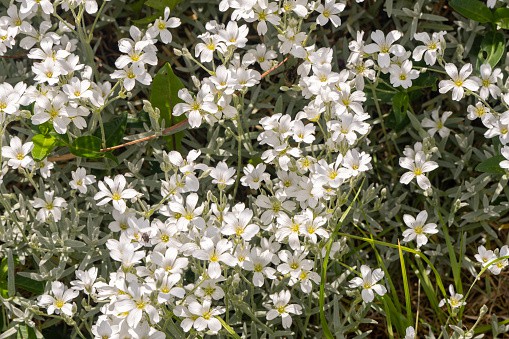Snow in Summer, or Cerastium Tomentosum, is a low-growing perennial that has been around for thousands of years. Its scientific name is derived from the Greek word “Kerasteion”, meaning “of a wool-like texture”. This aptly describes the woolly-feeling foliage of this beautiful, star-shaped flower. Its common alternate name is Jerusalem Star, for its resemblance to a five-pointed star in religious imagery. The Snow in Summer adds color, texture, and ground coverage to gardens, and can be planted in both indoor and outdoor potting.
How to Plant
Snow in Summer is considered to be fairly low-maintenance and is suitable for gardens in both temperate and warm climates. They grow best in full sun, but can also tolerate partial shade. Preferring well-draining, slightly alkaline soils, these plants will usually thrive in almost any condition. When planting, simply dig a hole and arrange the seeds at the correct depth, leaving at least a foot between each one. Water your plants regularly and add additional fertilizer if necessary.
Meaning and Symbolism
Snow in Summer has a history of religious and spiritual significance and has been used in many cultures as floral decoration. It is generally associated with purity, faith, and youth. In Christianity, the five-pointed star shape of the flower has been used to symbolize Jesus’s five wounds suffered during the Crucifixion. In Hinduism, the star has been used to symbolize the many-rayed wheel of life.
History, Mythology, and Religious Significance
In Christian religious imagery, Snow in Summer is a reminder of Jesus’s wounds and suffering, as the shape of the flower resembles the five-pointed star associated with his suffering. In Hinduism, the Snow in Summer is used to symbolize the many-rayed wheel of life and purity. In Irish mythology, it is one of the three plants discovered by the goddess of the underworld, Morrigan. It is also associated with everlasting youth and faith.
Flower Varieties and their Defining Characteristics
Snow in Summer comes in a variety of colors, shapes, and sizes. The most common type of Snow in Summer is the large-petalled, white-flowered variety, but there are also varieties that produce pink, purple, and yellow flowers. All varieties of Snow in Summer have a common star-shape with notched edges. The complex “star-shape” is a defining characteristic of this variety.
How To Pot and Repot
Once potted, Snow in Summer plants should be treated like any other houseplant. When potting Snow in Summer, choose a pot that is slightly larger than the roots of the plant, yet not so large that the soil becomes too wet. The best type of soil for Snow in Summer plants is soil that is both well-draining and slightly alkaline. Water the soil around the plant until it is lightly moist, but not soggy.
How To Prune
Pruning is the best way to maintain the shape and size of Snow in Summer plants, as well as encourage new and healthy growth. The best time to prune is in the spring, just before the start of new growth. Pruning should be done after flowering has finished as well. In order to keep your plant in shape and free of dead leaves, lightly prune every few months. If a particularly large growth is desired, a heavier pruning is necessary. To achieve this, remove the spent flowers, as well as two or three of the oldest leaves.
How To Propagate
Snow in Summer can be propagated from both seeds and cuttings. Seeds should be planted during the late spring and early summer. Cuttings should be taken in the summer, when the best growth has already been achieved. When taking cuttings, make sure that they are healthy, have at least three leaves, and that they are at least four inches in length. Place the cuttings in a damp mix of potting soil and sand and keep them moist for the first month. Once planted, Snow in Summer can take up to three weeks to flower.
Common Pests and Diseases
Snow in Summer is not prone to any major pests or diseases, but like all house plants, it can be susceptible to fungal infection and mildew. To avoid mildew and other problems, keep your Snow in Summer in a humid environment and in bright, indirect sunlight. Trim off any affected or dead leaves as soon as possible. Monitor your plant daily for signs of stunted growth, yellowing of the leaves, Pythium root rot, and Nematodes, which are all potential problems to be aware of.
Three Frequently Asked Questions About Cerastium Tomentosum
- What color do Snow in Summer flowers come in?
Snow in Summer flowers come in a variety of colors, such as white, pink, purple, and yellow. - How can I propagate Snow in Summer plants?
Snow in Summer plants can be propagated from both seeds and cuttings. Seeds should be planted in late spring/early summer, and cuttings should be taken in the summer when the best growth has been achieved. - What care does Snow in Summer need?
Snow in Summer plants need water, sunlight, and well-draining soil. Prune them occasionally for new and healthy growth, and be aware of fungal infections, mildew, Pythium root rot, and Nematodes.
Snow in Summer Fact Sheet
| Flower | Details |
|---|---|
| Snow in Summer | Cerastium Tomentosum |
| Family | Caryophyllaceae |
| Plant Type | Perennial |
| Mature Size | Up to 6 inches (15 cm) high |
| Sun Exposure | Full sun or partial shade |
| Soil Type | Well-draining and slightly alkaline soil |
| Soil pH | 7.0 – 8.0 |
| Bloom Time | Summer to early Fall |
| Flower Color | White, pink, purple, and yellow |
| Hardiness Zones | 3 to 9 |
| Native Area | Mediterranean region |
What we love from Amazon this week
Buy these wonderful flowers directly from Amazon:















